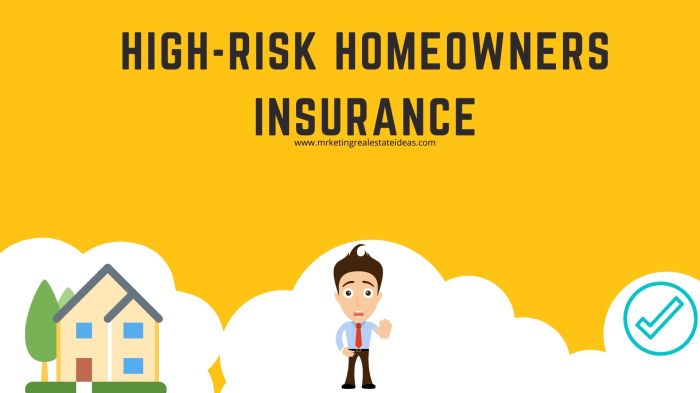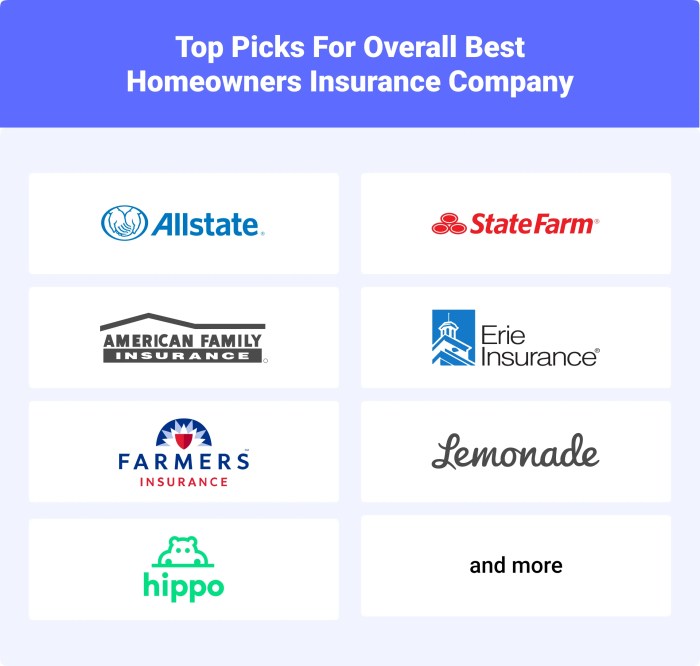Best home insurance companies for homeowners in high-risk areas are a crucial consideration for those living in areas prone to natural disasters, high crime rates, or other risks. These areas often come with higher premiums, so finding the right coverage at a competitive price is essential.
Understanding the unique needs of these locations and the coverage options available is key to finding the best fit for your home and budget.
This article delves into the factors that contribute to a home being located in a high-risk area, explores essential insurance coverage types, and examines the top companies offering comprehensive protection for homeowners in these challenging environments. We’ll also discuss how to choose the right insurer, obtain competitive rates, and review your policy regularly to ensure it meets your changing needs.
Defining High-Risk Areas: Best Home Insurance Companies For Homeowners In High-risk Areas

It’s essential to understand what constitutes a high-risk area when looking for home insurance. These areas often come with higher premiums due to increased likelihood of certain events that could damage your property.
Factors Contributing to High-Risk Areas
Several factors contribute to a home being located in a high-risk area. These factors increase the likelihood of damage to your home, leading insurance companies to charge higher premiums.
- Natural Disasters: Homes in areas prone to hurricanes, earthquakes, wildfires, floods, or tornadoes face a higher risk of damage. The frequency and severity of these events significantly influence insurance rates.
- Crime Rates: Areas with high crime rates, particularly property crimes like theft and vandalism, are considered high-risk.
Insurance companies factor in the likelihood of claims due to these events.
- Proximity to Water Bodies: Homes located near coastlines, rivers, or lakes are more vulnerable to flooding and storm surges. This proximity significantly impacts insurance premiums.
- Age and Condition of Homes: Older homes with outdated infrastructure or poor maintenance are more susceptible to damage and may require higher premiums.
- Local Government Regulations: Building codes, zoning regulations, and other local government policies can impact the risk associated with a particular area. Stricter regulations often lead to safer homes and lower premiums.
- Fire Hazards: Areas with dense forests, dry brush, or proximity to industrial facilities pose a higher risk of fire.
This increased risk is reflected in insurance premiums.
Examples of High-Risk Areas
Several areas across the United States are considered high-risk for various reasons.
- Hurricane-Prone Areas: Coastal regions along the Gulf of Mexico and the Atlantic Coast, such as Florida, Louisiana, and Texas, are particularly susceptible to hurricanes.
- Earthquake Zones: California, Alaska, and the Pacific Northwest are known for their seismic activity, making homes in these areas prone to earthquake damage.
- Wildfire Zones: California, Colorado, and Oregon experience frequent wildfires, leading to high insurance premiums in these regions.
- Flood-Prone Areas: Homes located near rivers, lakes, and coastlines are at risk of flooding, particularly in areas with frequent heavy rainfall or storm surges.
- High-Crime Areas: Urban areas with high crime rates often have higher insurance premiums due to increased risk of theft and vandalism.
Impact on Insurance Premiums
Insurance companies use various factors to calculate premiums, including the risk associated with the location of your home. High-risk areas generally have higher premiums to account for the increased likelihood of claims.
“The higher the risk, the higher the premium.”
For example, a homeowner in a hurricane-prone area may pay significantly more for their insurance than someone living in an area with a lower risk of hurricanes.
Understanding Home Insurance Coverage
Home insurance is a crucial aspect of protecting your most valuable asset – your home. Understanding the coverage options and what they encompass is vital to ensure you have the right protection.
Essential Coverage Types
A standard homeowner’s insurance policy includes several essential coverage types designed to protect you from various risks. Here’s a breakdown:
- Dwelling Coverage:This coverage protects your home’s structure, including the attached garage, from damage caused by covered perils like fire, windstorms, hail, and vandalism. It covers the cost of repairs or rebuilding, up to the policy limit.
- Other Structures Coverage:This coverage extends protection to detached structures on your property, such as fences, sheds, and swimming pools, up to a certain percentage of the dwelling coverage.
- Personal Property Coverage:This coverage protects your belongings inside your home, including furniture, appliances, electronics, and clothing, from covered perils. It typically covers up to 50-70% of the dwelling coverage.
- Loss of Use Coverage:If your home becomes uninhabitable due to a covered peril, this coverage provides temporary living expenses, such as hotel costs and meals, until your home is repaired or rebuilt.
- Personal Liability Coverage:This coverage protects you from financial liability if someone is injured on your property or if you are found legally responsible for damage to someone else’s property.
Additional Coverage Options
While essential coverage types provide a baseline of protection, additional coverage options can enhance your insurance policy to address specific risks in high-risk areas.
- Flood Insurance:This coverage is crucial in areas prone to flooding, as standard homeowner’s insurance policies typically exclude flood damage. It provides financial protection for flood-related damage to your home and belongings.
- Earthquake Insurance:In earthquake-prone regions, this coverage is essential to protect your home from damage caused by earthquakes. It can cover repairs, rebuilding, and even temporary living expenses.
- Personal Liability Coverage:This coverage extends the standard liability protection to cover accidents that occur off your property, such as if you accidentally injure someone while driving or walking.
It’s important to note that additional coverage options may come at an extra cost, but they can provide peace of mind and financial protection in high-risk situations.
Top Home Insurance Companies for High-Risk Areas
Finding the right home insurance company can be a challenge, especially if you live in a high-risk area. You need a company that understands the unique risks you face and offers comprehensive coverage at a fair price.
Top Home Insurance Companies for High-Risk Areas
Here are some of the top home insurance companies that are known for their expertise in insuring homes in high-risk areas:
| Company Name | Coverage Options | Pricing Transparency | Customer Service Ratings |
|---|---|---|---|
| State Farm | Offers a wide range of coverage options, including flood insurance and earthquake insurance. | Provides clear and concise pricing information on its website and through its agents. | Consistently ranks high in customer satisfaction surveys. |
| Allstate | Provides comprehensive coverage for a variety of risks, including windstorms, hail, and wildfires. | Offers a variety of discounts and flexible payment options. | Has a strong reputation for customer service and claims handling. |
| Farmers Insurance | Specializes in insuring homes in high-risk areas, including coastal regions and areas prone to wildfires. | Provides competitive pricing and a variety of coverage options. | Has a strong track record of customer satisfaction and claims handling. |
| USAA | Offers a wide range of coverage options, including flood insurance and earthquake insurance. | Provides clear and concise pricing information on its website and through its agents. | Consistently ranks high in customer satisfaction surveys, but only available to military members and their families. |
Factors to Consider When Choosing a Home Insurance Company

When choosing a home insurance company, it’s crucial to consider more than just the price. Several factors play a significant role in ensuring you get the best possible coverage and service.
Financial Stability and Claims Handling Experience, Best home insurance companies for homeowners in high-risk areas
The financial stability of an insurance company is essential, especially in high-risk areas. You want to make sure the company can pay out claims if you need them. One way to assess financial stability is to check the company’s credit rating, which is a measure of its financial health.
You can also look at the company’s claims handling experience, which reflects how well it handles claims and how quickly it pays them out. A company with a strong claims handling record is likely to be more reliable and responsive in the event of a disaster.
Customer Service and Online Tools
Excellent customer service is vital, especially when dealing with a potentially stressful situation like a home insurance claim. Look for a company that offers various communication channels, such as phone, email, and live chat, and has a reputation for prompt and helpful service.
The availability of online tools for managing your policy can also be beneficial. Features like online policy management, claim filing, and payment options can make it easier to handle your insurance needs.
Tips for Obtaining Competitive Home Insurance Rates

Getting the best possible home insurance rate requires a proactive approach. It’s not just about comparing quotes; it’s about making strategic choices that demonstrate your commitment to responsible homeownership.
Improving Home Safety and Security Features
Making your home safer and more secure can significantly lower your premiums. Insurance companies recognize that homes with enhanced safety features are less likely to experience claims, leading to lower risks for them.
- Install Security Systems:Having an alarm system, especially one monitored by a security company, can lead to substantial discounts. The presence of an alarm system can deter potential burglars, reducing the risk of theft and property damage.
- Upgrade Locks:Replace old, easily-breakable locks with high-quality deadbolts. Secure your windows with strong, sturdy locks. These simple upgrades can make it much harder for intruders to gain entry, reducing your risk of theft.
- Invest in Fire Safety Devices:Installing smoke detectors and carbon monoxide detectors throughout your home is essential for safety and can also earn you discounts. Consider a sprinkler system for additional protection against fire damage.
- Improve Roof Condition:A well-maintained roof is crucial for protecting your home from weather damage. Replacing old or damaged shingles, ensuring proper ventilation, and keeping gutters clean can reduce the risk of leaks and water damage, leading to lower premiums.
Comparing Quotes from Multiple Insurers
Shopping around for quotes from different insurers is crucial for finding the best rate. It’s not uncommon to find significant differences in pricing, even for similar coverage.
- Use Online Comparison Tools:Many websites and insurance brokers allow you to compare quotes from multiple insurers simultaneously. This saves you time and effort in the research process.
- Contact Insurers Directly:Don’t rely solely on online comparison tools. Reach out to insurance companies directly to discuss your specific needs and obtain personalized quotes.
- Ask About Discounts:Inquire about available discounts for various factors, such as:
- Homeowner Discounts:Many insurers offer discounts for homeowners who maintain their homes well and have a good claims history.
- Bundling Discounts:Combining your home and auto insurance policies with the same insurer can often result in substantial savings.
- Safety Feature Discounts:As mentioned earlier, installing security systems, fire safety devices, and other safety features can qualify you for discounts.
Concluding Remarks

Living in a high-risk area requires careful consideration of your home insurance needs. By understanding the factors that influence premiums, exploring available coverage options, and choosing a reputable company with strong financial stability, you can secure the protection you need to safeguard your home and peace of mind.
Remember to review your policy regularly to ensure it remains relevant to your changing circumstances and risk factors. With the right approach, you can find the best home insurance for your unique situation and navigate the challenges of high-risk living with confidence.
Questions Often Asked
What are some common factors that make a home a high-risk area?
Common factors include proximity to wildfire zones, floodplains, earthquake fault lines, high crime rates, and areas with a history of severe weather events like hurricanes or tornadoes.
Do I need additional coverage for my home in a high-risk area?
Yes, you might need additional coverage like flood insurance, earthquake insurance, or specialized coverage for specific risks like sinkholes or landslides.
How do I find the best home insurance company for my needs?
Research companies, compare quotes, consider financial stability and claims handling experience, and look for customer service and online tools that align with your preferences.
